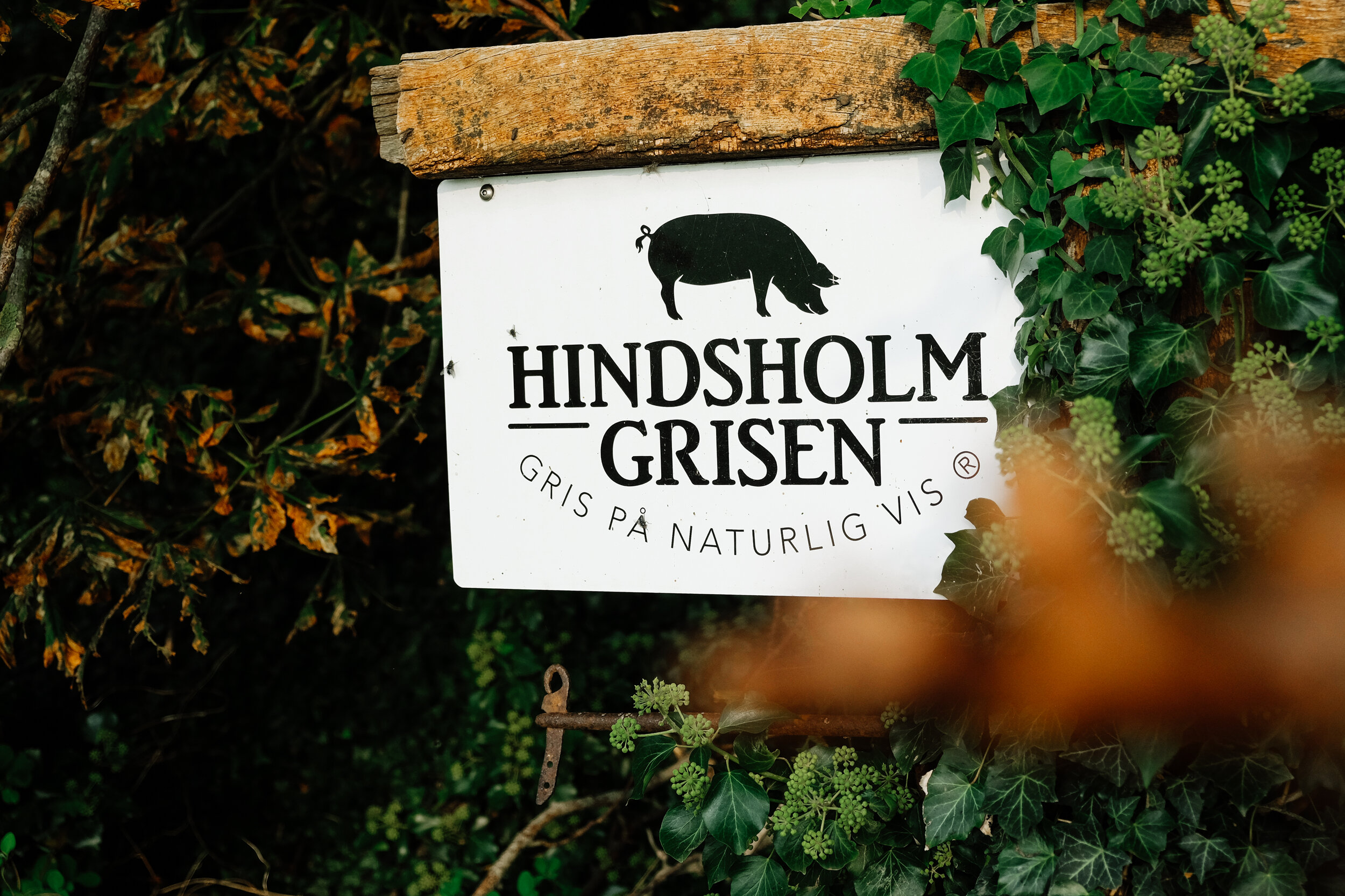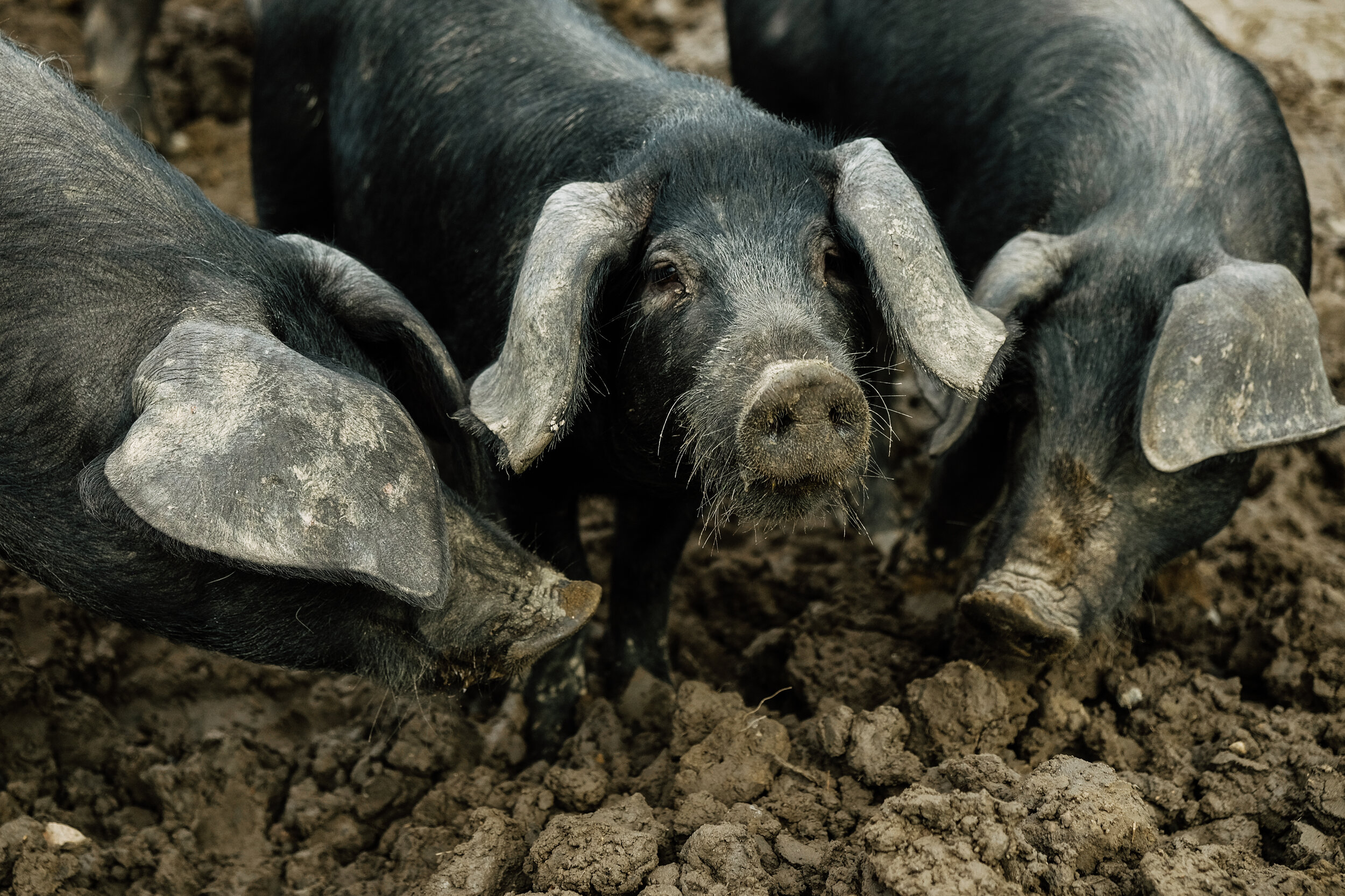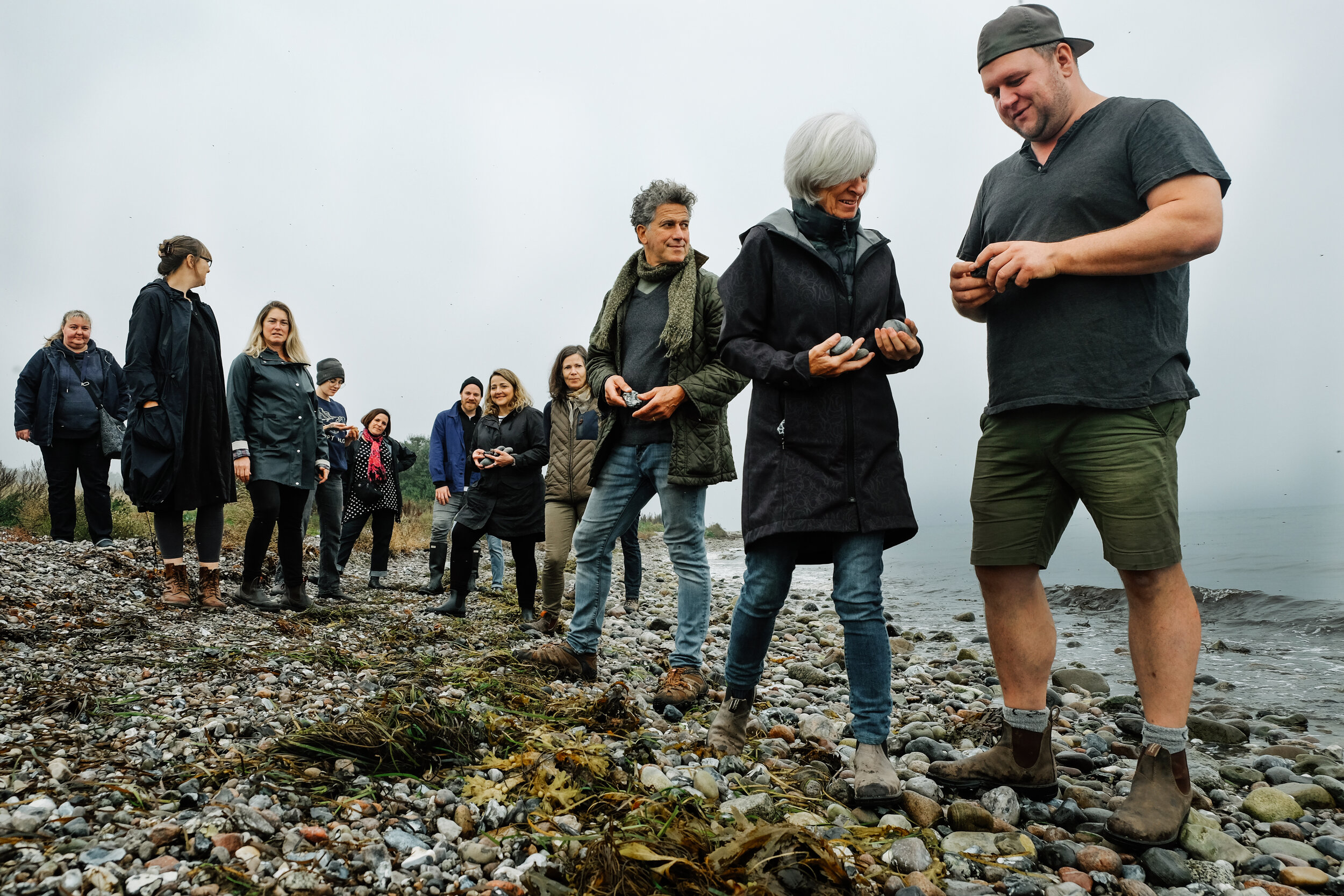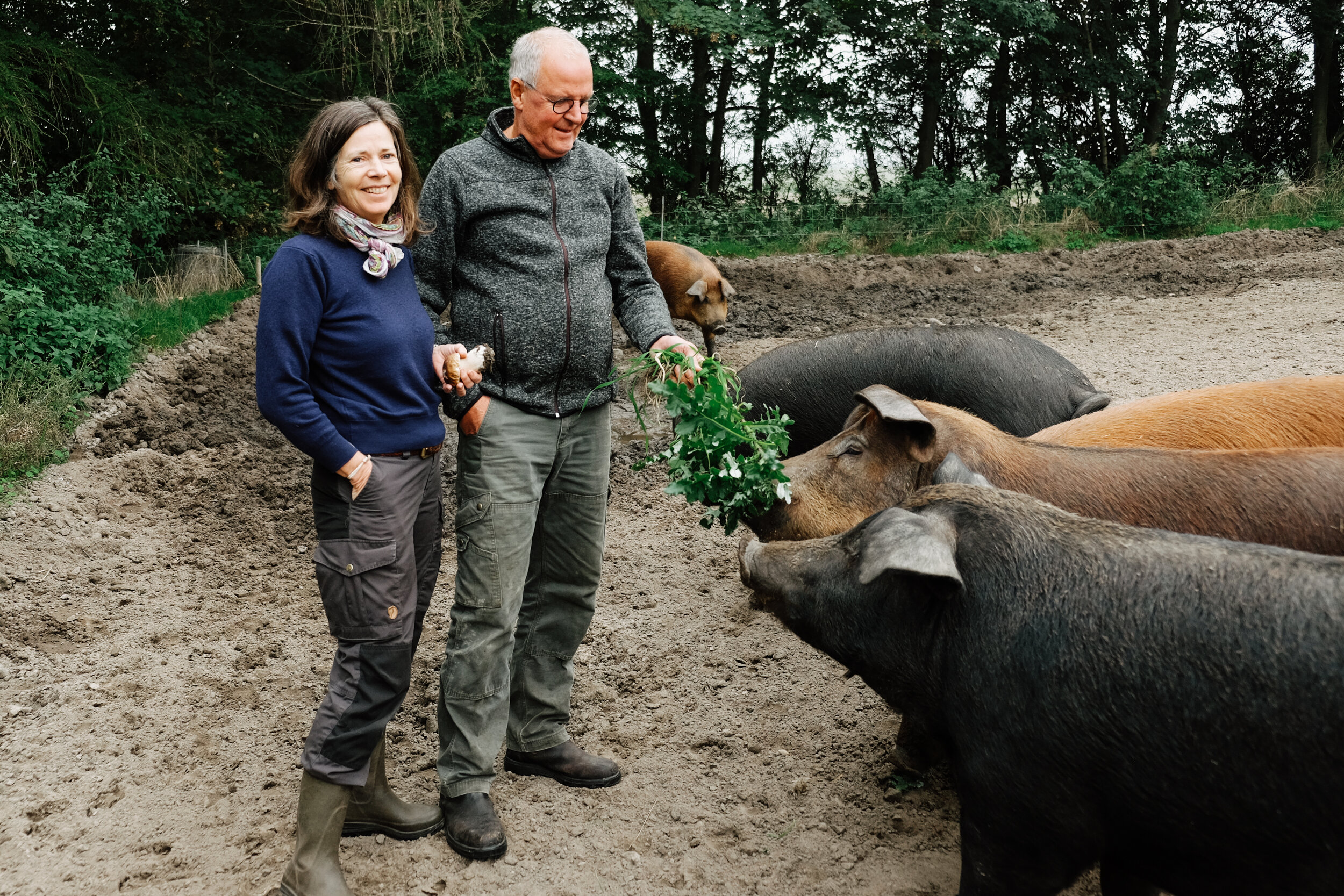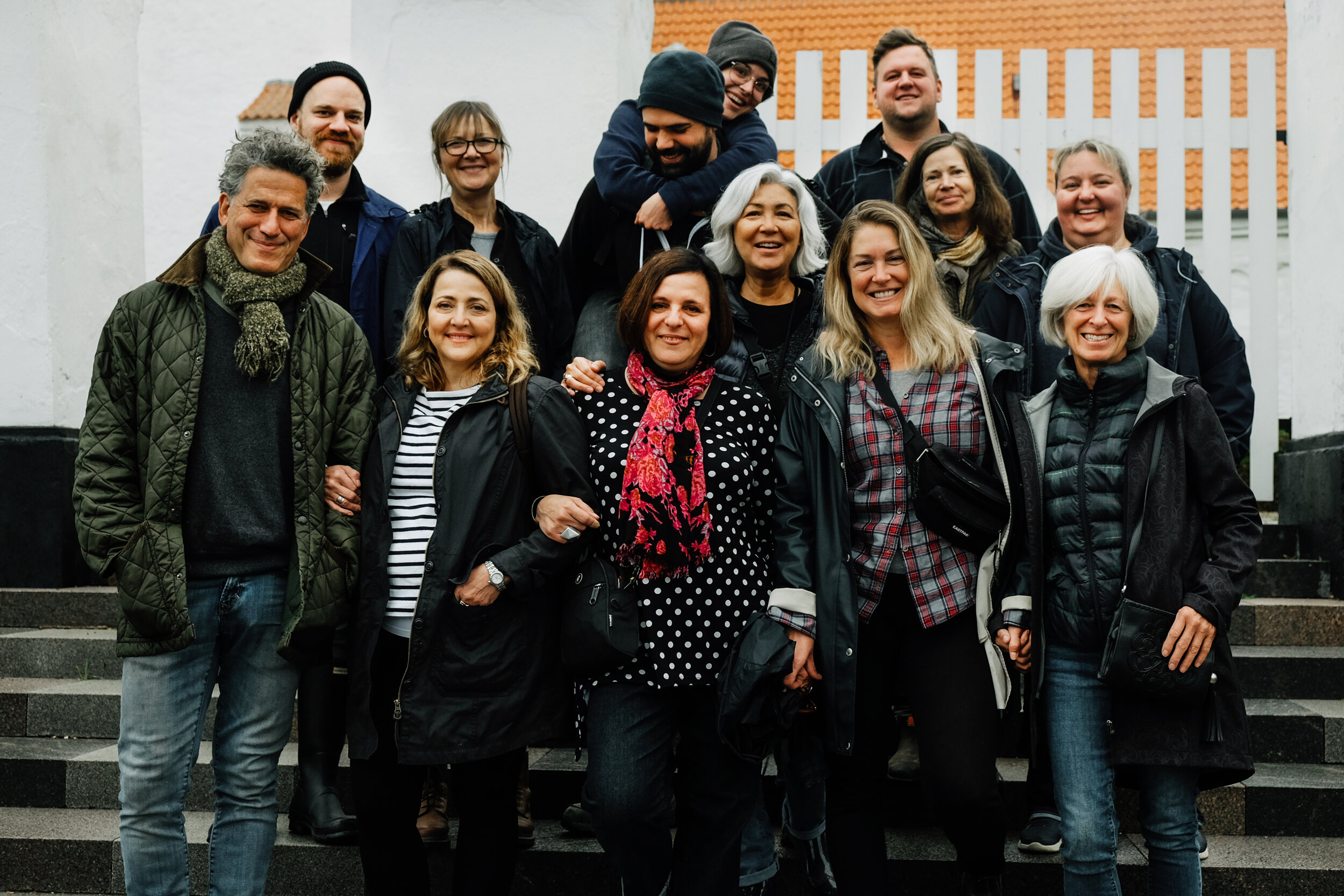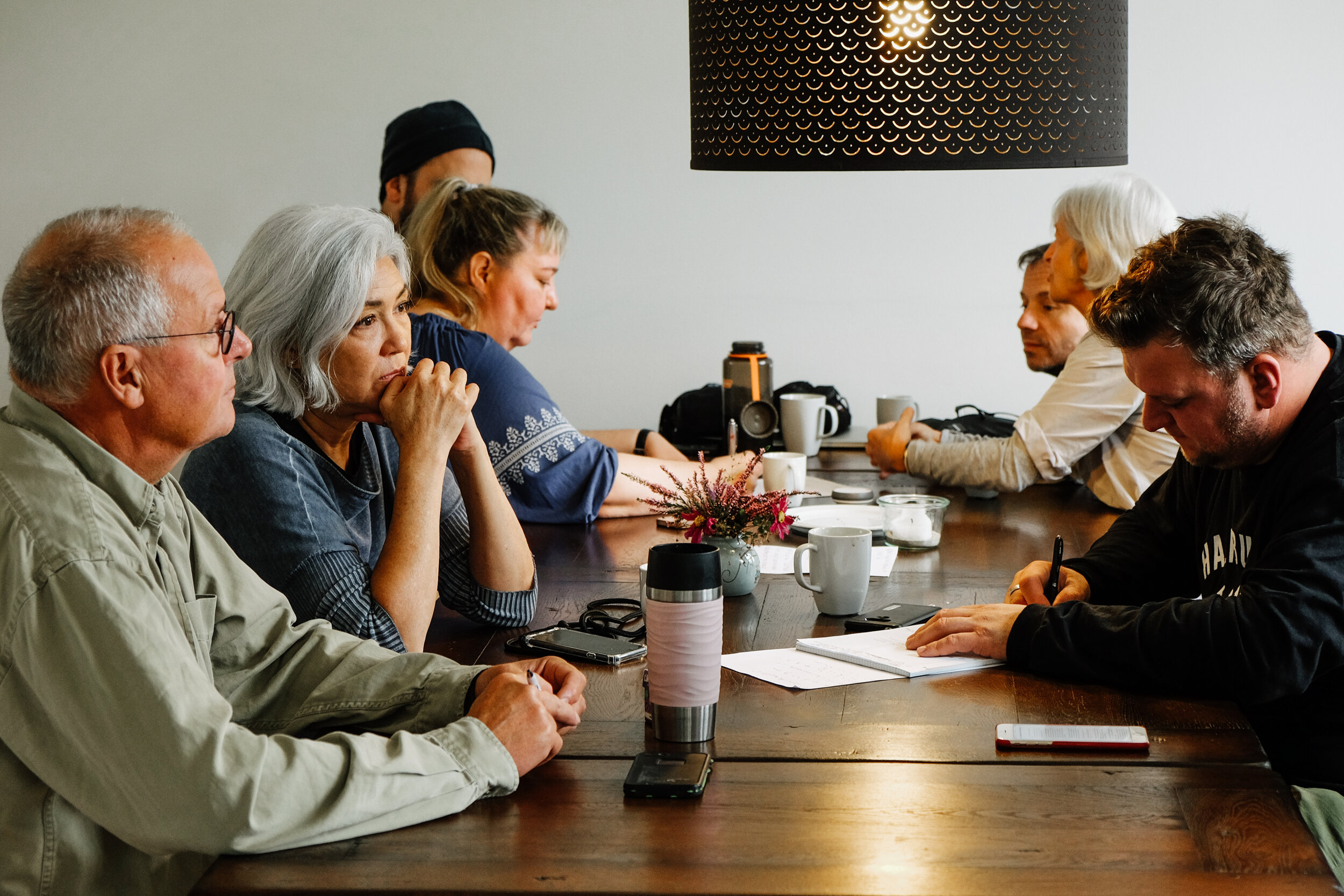To demonstrate ecological and financially sustainable farming practices we introduced a group of 16 hospitality professionals to HindsholmGrisen, a wholly sustainable pig farm on the tiny Danish island of Fyn.
interdisciplinary - cross cultural exchange - sustainable BUSINESS -
Ecological Farming systems - COMMUNITY
About HindsholmGrisen
Photo: Rebecca Hoffman
HindsholmGrisen is owned by Poul and Carla Nielsen and is located just two hours from Copenhagen. Since 2011 they have been raising pigs in a happy environment, as close as possible to what nature intended for them had they been living in the wild. Together with three employees they raise, feed, slaughter, butcher and produce products from the 300 hectare organic farm.
Poul and Carla see education as a matter of transparency and translating values in order to support food and farming models across the world. The Terroir Denmark learning journey helped create exactly this dialogue as well as providing cultural exchange and education for hospitality professionals.
What we did
Learned the basics of animal husbandry and sustainable pig production
Butchery workshops with a master producer
Learned about danish processing methods, sausage making and smoking techniques
Foraged in the local countryside and explored native orchards
learned the history and archaeology of the land
Learned how food and farming has evolved over the centuries
Discussed how food and farming models will continue to evolve
Photo: Rebecca Hoffmann
What we learned
Photo: Rebecca Hoffmann
What sustainable farming means and how to practise it
How to run a sustainable farm system
Ecological business approaches
Danish cultural touchstones
Industry respect and community growth
How to butcher an animal
Hands-on environmental experience
Itinerary
Photo: Rebecca Hoffmann
DAY ONE
Terroir Denmark started with smørrebrød and schnapps at Poul & Carla’s house with an introduction to Hygge. Groups then created a meal plan for the week based on produce that’s readily available at the farm including potatoes, beets, chard, purple beans, mystery squashes, leafy broccoli, parsnips, kale, apples, hazelnuts, rye and barley.
Photo: Rebecca Hoffmann
DAY TWO
A morning butchery masterclass with Line Vest as the group learned about the Danish methods of processing whole animals, including the various cuts of meat it produces.
After a farm tour and history lesson about rural Danish farm communities. We then had dinner discussing Danish landscapes with local resident and landscape architect, Hanne Bat Finke.
DAY THREE
Photo: Rebecca Hoffmann
After a morning of farm chores and beach foraging we then had a traditional Danish lunch in Kerteminde of hot dogs and smoked fish.
In the afternoon we embarked on a tour of the Mussel Cooperative in Kerteminde - a business which works to help clean and clear the ocean waters.
During dinner, we heard from Eigil Nicolajsen, a local archaeologist and writer, as well as Julia Dalmadi, a food innovation expert on the future of protein.
Photo: Rebecca Hoffmann
DAY FOUR
Today we join Poul and his farm hands to understand how the life of a pig comes to an end. Lessons include how to make sausages and smoking meat with the HindsholmGrisen crew.
We enjoy the farm’s bounty with a simple homemade frikadelle and Jerusalem Artichoke soup. The artichokes grow in excess on the farm as a way of restoring the soil and the pigs love to eat them – this excessive root is literally ‘dirt candy’.
During dinner, Poul & Carla talk about what exactly sustainable farming is and how to realise it, anywhere in the world.
Photo: Rebecca Hoffmann
DAY FIVE
Our final day started with a workshop reflecting on all we’d learned and everything we’d be taking away from the Terroir Denmark experience.
The day was they spent preparing, planning and enjoying a celebratory BBQ prepared collaboratively by the entire team.
Takeaways
“Having the ability to spend time on a farm with this connection to the animals gives me, as a butcher, a better perspective. Being in a different country with different practices, allows me to get a different perspective on how I might butcher or market our products and it allows me to share this knowledge with my customer. ”
“In curating a program that allowed participants to engage in a week of farm-based activities, participants were able to develop a true understanding of the challenges and benefits of running a sustainable farm.”
“Coming from a kitchen background I’ve always found it to be a strong tool knowing where our product comes from, how its raised and what makes it so tasty and special. Having a strong relationship with our farmers gives us the ability to work closer with them so we can better understand each others needs.”
“The price of protein should be able to provide a stable income for the farm family. The price of meat should be set by the farmer and reflect the true cost of producing the products which includes a fair profit.
”
We need to talk about…meat
By Helen Underwood, White Cottage Bakery, UK
The mood is sombre as we gather at the edge of the field, just metres away from the house in which we are staying this week. Perhaps we are a little nervous. The joking and bonhomie have ceased for a while. Poul, our host, has brought a small group of us to witness the profound act that is about to take place. He has everything in order; everything prepared to make what follows quick, painless and stress-free. He throws a handful of meal down for the gathering animals then deftly presses the electric charges either side of the chosen pig, once through the brain, then through the chest. The animal slumps quietly at the first. The other animals keep eating as the pig is then hoisted out of the field and bled, feet away. If they have noticed, they show no sign.
We have just witnessed the slaughter of one of Poul’s pigs, here at HindsholmGrisen, the organic pig farm in Denmark where he is demonstrating a new way forward in the rearing of animals for meat production. The word ‘slaughter’ is heavy with imagery, frequently teamed with ‘senseless’ when referring to war or genocide. But the scene here is far removed from such connotations of the word. This has been calm. It has been quiet. It has been respectful.
Photo: Rebecca Hoffmann
Poul and his wife Carla run this remarkable operation with approximately 300 pigs on 20 hectares of land. Their house is surrounded by the fields in which they keep the pigs or grow organic crops that will sustain them. And the first thing that strikes us all, is the smell of the fresh, clean sea air. The picnic table on the edge of their apple orchard sits beside the pigs, who gather curiously as we take refreshments. The lack of smell is remarked upon by us all. Especially given where we are – a pig-producing region of Denmark, where the smell of pig manure often hangs heavy in the air, pervading both indoors and out.
We toss some of the apples to the pigs, as we take a tour of the farm. Everything happens right here, from birth through to sausage production. The animals never need to be transported alive, unlike the fate of millions of other Danish pigs. We walk amongst them and note their varying sizes, some piglets twice the size of others. This, Poul tells us, is the result of their natural diet and free-range feeding habits. Every day they are fed on fresh grass, chopped with a ground meal of organic barley, oats and peas. The young piglets grow at differing rates and, as they are destined to live considerably longer lives than their intensively farmed contemporaries, there is no hurry to fatten them.
We are taken into the fields where, this year, they are growing Jerusalem artichokes, also known as sunchokes or earth apples. The yellow flowers tower above us as we beat our way through the woody stems and Poul stoops to dig one up. The small, delicious tubers lie just below the surface, much as a potato grows. The pigs will clear the fields, section by section, harvesting the crop themselves and allowing them to exhibit their natural rooting behaviour.
Our farm tour over, we change and move inside. We first visit the room where the pig, whose death we have witnessed, is being prepared for veterinary inspection and later, butchering. The government vet is responsible for visiting small abattoirs and the few licenced farmers, like Poul, to inspect both the recent health of the animal and the manner of its death. Most Danish pigs, however, are dealt with at one of two large cooperative abattoirs – a throughput of millions each year. The time and attention we have witnessed so far could not possibly be afforded to all those animals.
Denmark is home to about 5000 pig farms and around 3000 of these are super-farms, housing more than 5000 pigs. And yet as I travelled the two hours from Copenhagen to Poul and Carla’s farm, I spotted not a single pig. Coming from the UK, where 40% of the pig population is farmed outdoors, I had expected to see the fields full of sows and piglets, their familiar corrugated shelters dotting the landscape. Here, the pigs are invisible. Their welfare – or lack of it – is a matter for the production unit owners, their workers and the government. The consumer is blissfully, or maybe wilfully, ignorant.
90% of Denmark’s 28 million pigs slaughtered each year are destined for export. Such is the worldwide demand for pork; in many parts of the world, it is customary to eat meat three times a day. And, it has to be said, Denmark’s welfare and food safety standards are very high compared with much of the rest of the world and many of the countries it exports to.
Simply stated, to satisfy current demand, it would be impossible to produce pigs as Poul and Carla do, on small scale operations, slaughtering in a painless and stress-free way and without live transportation.
And here’s the rub: we need to reduce production. We need to eat less meat. We have to reconnect with the process. We have to see the meat we eat as once a living animal that ought to be respected. It should not be a throw-away, disposable commodity. If we are prepared to eat meat, we must be prepared to understand and engage with the farming practices that have produced that meat. We must be prepared to eat less in order that we can pay more. We must be prepared to value this food for all that it is worth and all that it has come from.
Photo: Rebecca Hoffmann
The question is how do we effect this change?
At first, it seems like an impossibility – changing people’s attitudes to meat-eating and meat-production is fraught with economic, historical and cultural sensitivities. But then I am reminded of how far we have come in the UK and Europe with regard to egg production. In January 2012, legislation was brought in to end the battery farming of hens within Europe. A good start but, of course, there’s always wriggle-room in legislation and it didn’t put an end to caged birds altogether. However, consumer pressure in the UK meant that one by one supermarkets were under peer pressure to announce they would only sell free-range eggs. Many chain restaurants were hard on their heels. Because that’s what consumers demanded. Not perfect – plenty of room for improved welfare – but a big change in the last 20 years. However, crucially, this welfare change meant the consumer was faced with only a small premium in the price they paid.
High-welfare, small-production meat from regenerative farms would mean a huge increase in cost – maybe more than 100%. The world’s population cannot afford to pay such prices. But they can make choices. Not everyone. Not everywhere. But we can make a start. We can apply consumer pressure and outrage at intensively farmed meat from caged animals. We can connect with the process of meat production and share our knowledge with others. Let no one forget that that sterile, shrunk-wrapped polystyrene tray of meat in the supermarket was once a living, breathing animal and that it’s life mattered. We can ensure nothing is wasted – either from the butchered animal or from the meat we buy. No life is disposable. No meat should be thrown away. If we valued it more, we would pay more.
But the simpler truth is this: perhaps if we paid more, we would value it more.
